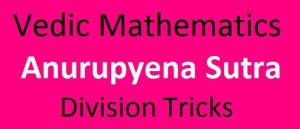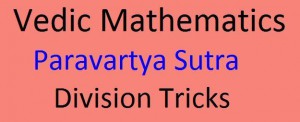Anurupyena & Vinculum Division using Vedic Mathematics when Nikhilam and Paravartya is not possible to be applied BUT if divisor is either multiplied or divided by some factor then it is possible. Anurupyena Sutra Division As seen earlier in Multiplication, Anurupyena means Proportion. Topics need to be known before starting: In this topic I will let you know the shortcut to divide numbers using Anurupyena Sutra. But before checking Anurupyena Methos below concepts are required. Basic Requisites page. Anurupyena method from Multiplication Nikhilam Method of Division Paravartya Specific Condition Required: As we know the meaning of Anurupyena (as proportion/ratio), we multiply/divide by factor to make divisor closer to larger number (To apply Nikhilam) OR to make closer to smaller number (To apply Paravartya). Later we multiply/divide QUOTIENT with same factor. Also Read => More Division Sutras in Vedic Mathematics Anurupyena Division Tricks: Its always good to use factors for multiplication instead of division because if division is used then on dividing Quotient by that factor might create non-integer i.e. a decimal quotient. To avoid overheads its better to use multiplication. It might follow or followed by Vinculum for simplicity purpose. Vinculum As seen earlier with bigger digits, calculation/process gets little bulky. So using Vinculum we need to convert bigger digits to smaller. Prerequisites: Vinculum and How to Play with Quotients and Remainders. Nikhilam and Paravartya Methods of Division As discussed earlier when we have larger divisor we apply Nikhilam and when we have smaller divisor we apply Paravartya. But when we have 1 or more larger digits (6,7,8,9) in divisor then calculating answer becomes little lengthy/time consuming also big multiplications are to be done. So we can convert such divisors in Vinculum Number. Example: # 2621/828 For already seen this example in … [Read more...]
Paravartya – Division using Vedic Mathematics
Paravartya Yogayat (Paravartya) Division in Vedic Mathematics when Divisor is CLOSER and SLIGHTLY GREATER than power of 10. Sanskrit Name: परवर्त्य योजयेत् English Translation: Transpose and Apply. Prerequisites: In this post I will guide you to shortcut to divide numbers using Paravartya Sutra. But before starting with Paravartya Sutra of Vedic Mathematics, below basic concepts are required. Vinculum & Concept of Playing with Quotients and Remainders Specific Condition Required: Lets see the what Paravartya Division Tricks are required in this Sutra. We apply this method when the Divisor is greater than power of 10 (10,100,1000, etc) and starts with 1. (The Divisor Need NOT to be JUST GREATER than power of 10 since large digits(6,7,8,9) can be converted to smaller digits(1,2,3,4) using Vinculum. Also if Divisor starts with other than 1 then we can apply Anurupyena Sutra. (see in Anurupyena & Vinculum)) As the name (Transpose and Apply) suggests we change the sign and apply the changed number. i.e. Addition will be turned to Subtraction , Division will be changed to Multiplication and vice versas. Remainder Theorem and Horner’s process of Synthetic Division are small parts of Paravartya Sutra. Also Check => More Division Sutras in Vedic Mathematics Examples: # 432/11 Discard the 1st digit(1) of Divisor(11) and take Transpose of remaining digits(i.e. -1 or Bar 1). Split Dividend in 2 parts (Quotient & Divisor) in such a way that Remainder part should have same number of digits thus obtained in 1st step.Thus remainder part will have only 1 digit Now carry the same process as done with previous (Nikhilam) method. If any bar digit is present in final answer, convert to Normal method using Vinculum. As seen instead of dividing we multiply and 11’s 1 is turned to -1 (i.e Transpose and Apply). As seen from last example (1356/182), using same above method we had to … [Read more...]

